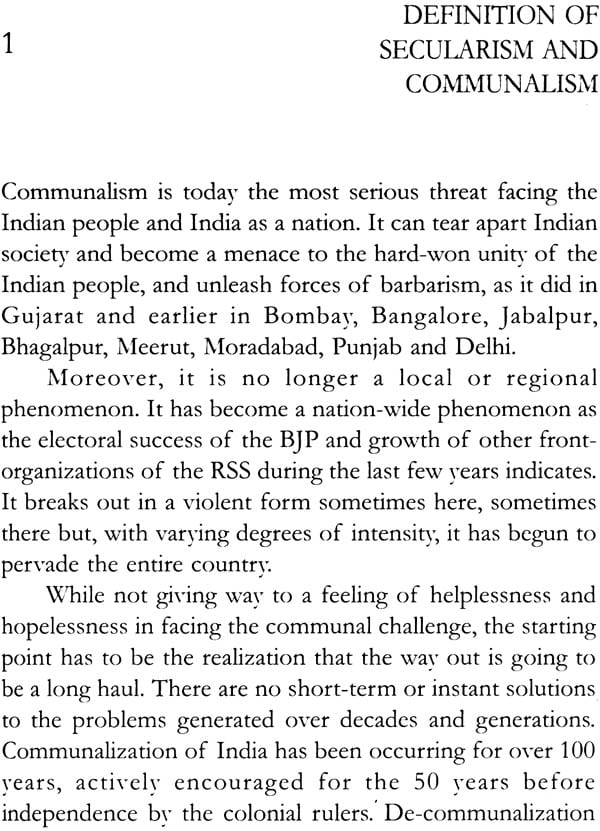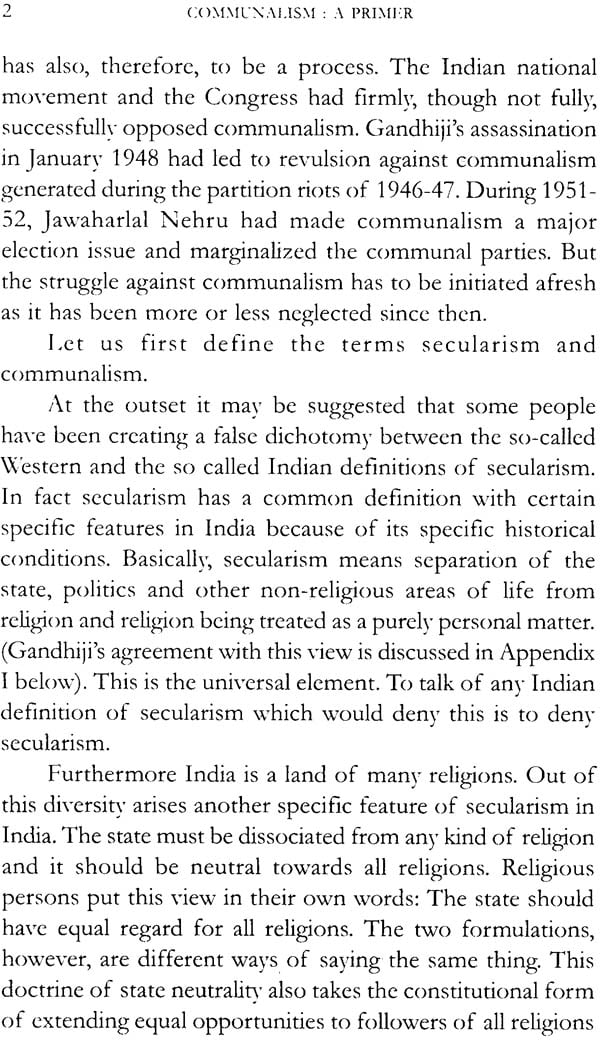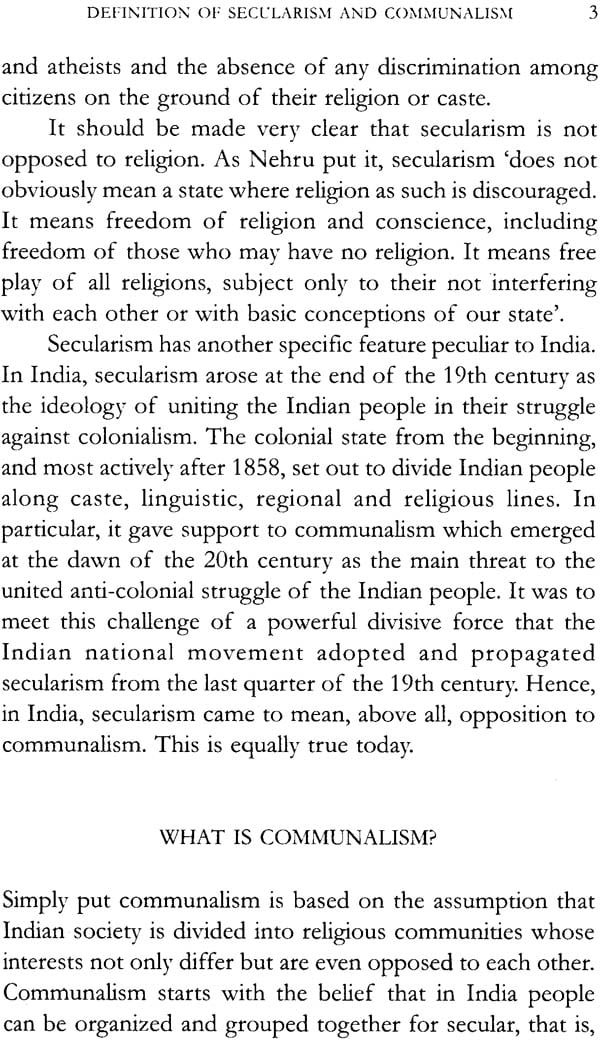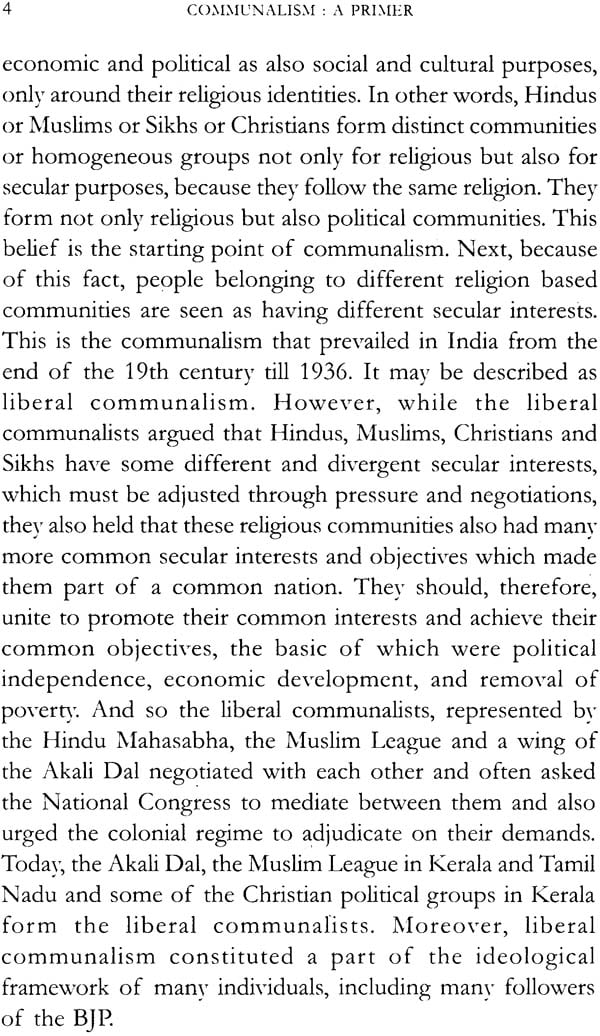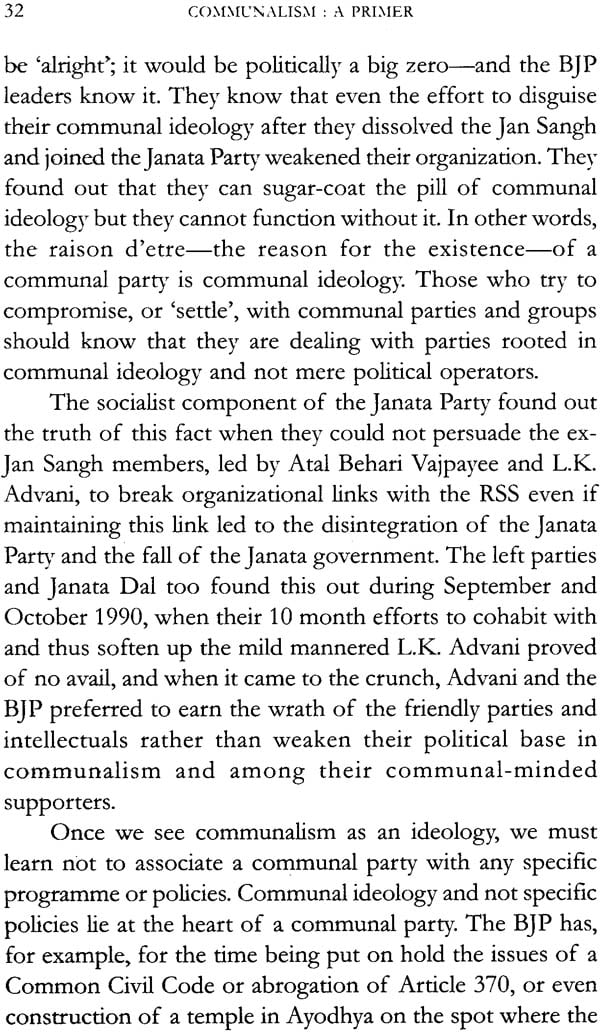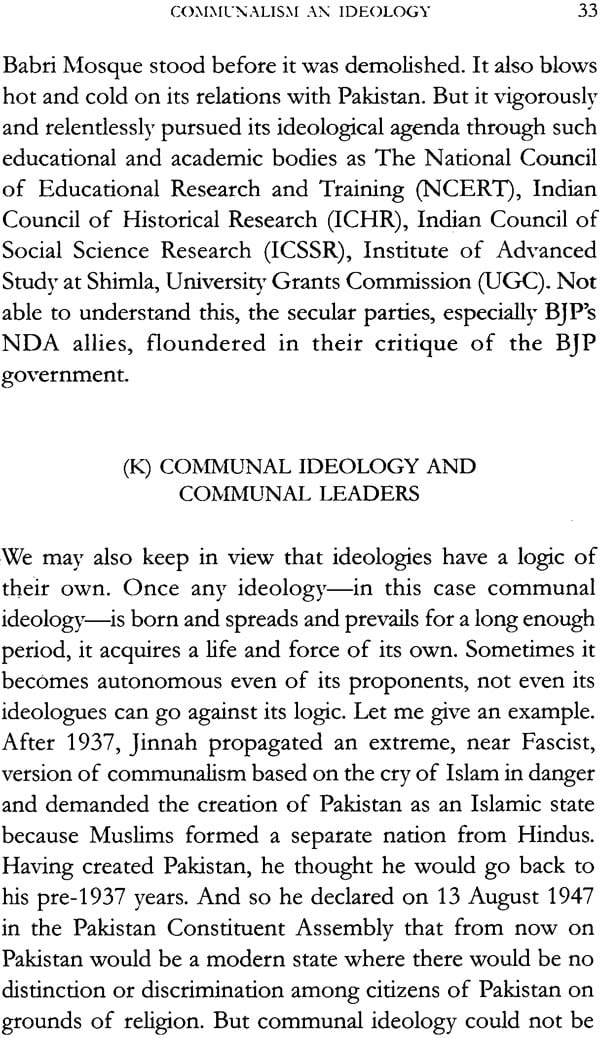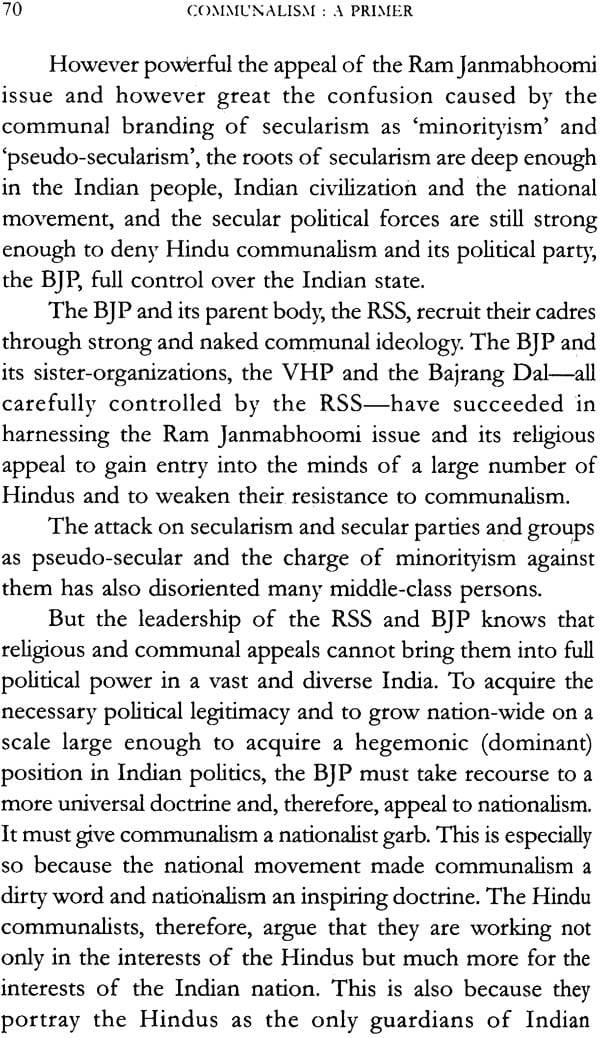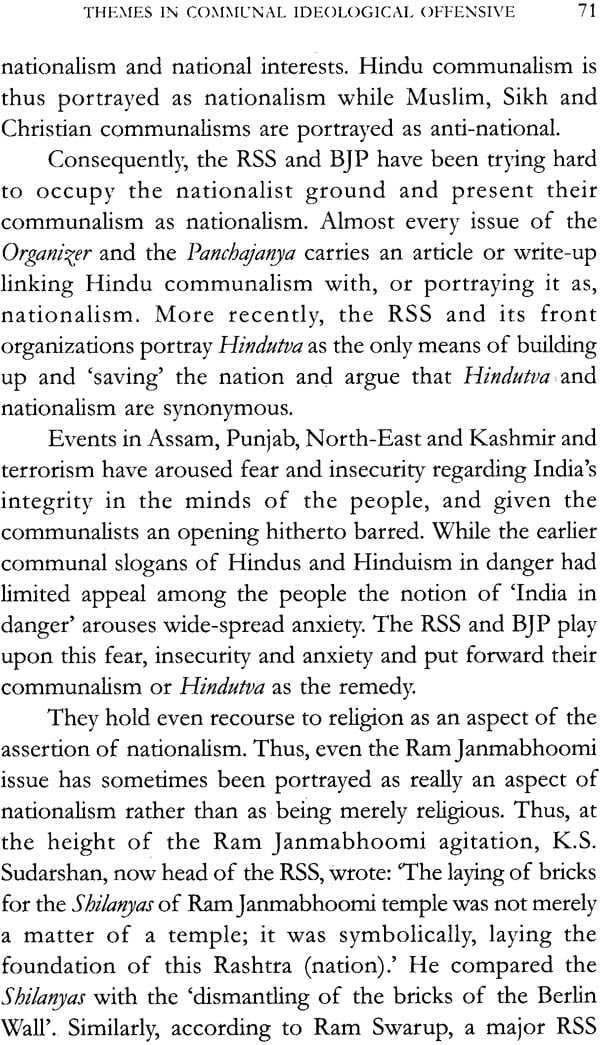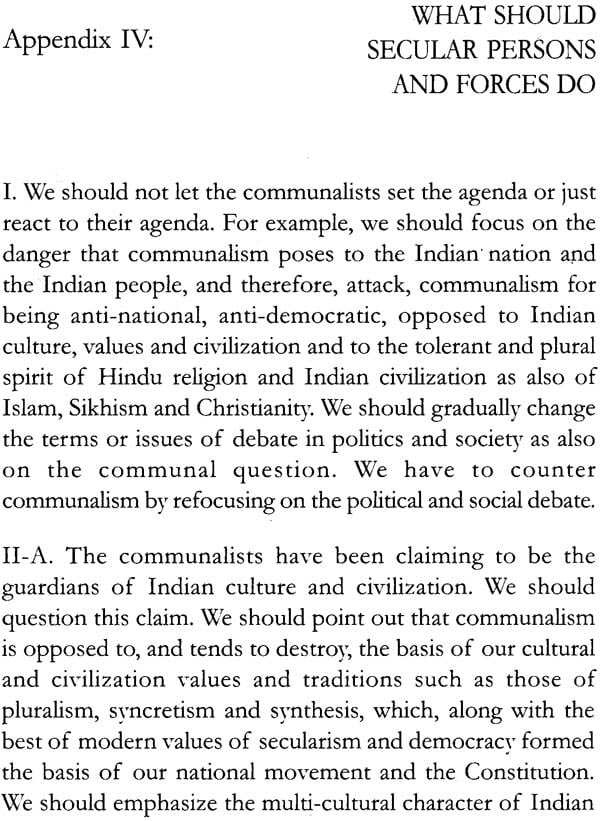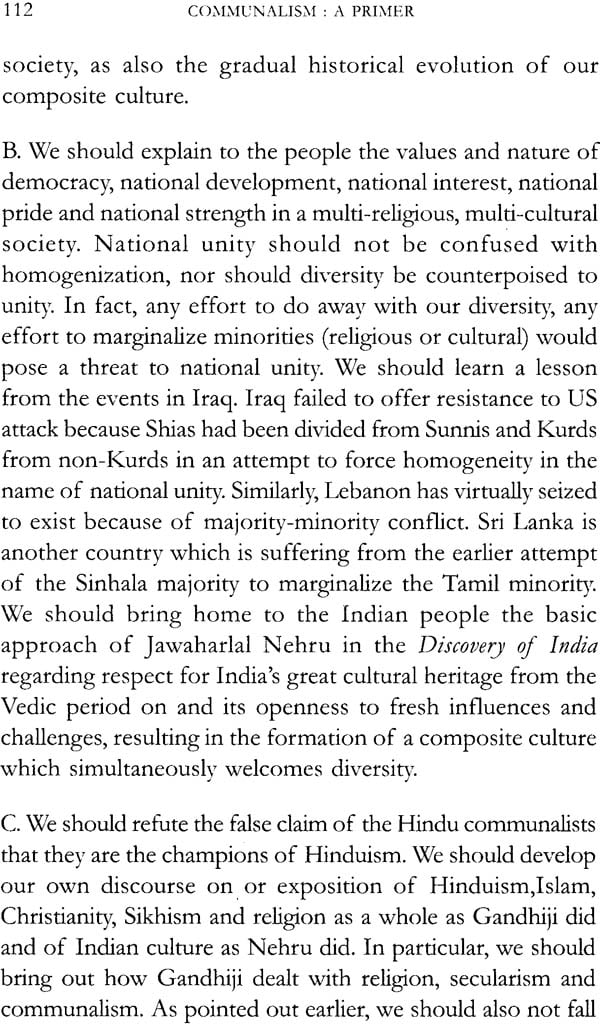
Communalism (A Primer)
Book Specification
| Item Code: | NAF727 |
| Author: | Bipan Chandra |
| Publisher: | National Book Trust, India |
| Language: | English |
| Edition: | 2016 |
| ISBN: | 9788123753607 |
| Pages: | 133 |
| Cover: | Paperback |
| Other Details | 8.5 inch x 5.5 inch |
| Weight | 200 gm |
Book Description
Communalism is today identified as one of the biggest threats facing society. The primer argues that while communalism is very often equated with religious fundamentalism, it actually represents an ideology. To counter it successfully, communal thinking has to be uprooted from people's minds. The struggle against communalism has to recognise the century-old heritage of inculcation and spread of communal ideology among the masses. The author argues that once the ideological character of communalism is recognised, combating it would require a dual-pronged strategy both at the political as well the ideational level. The primer offers a comprehensive study of key concepts such as the distinction between communalism and secularism; major themes in the communal ideological offensive and an inventory of practical dos and don'ts. A valuable contribution to the debate.
Bipan Chandra was born in Kangra, Himachal Pradesh. He was educated at Forman Christian College, Lahore, and at Stanford University. He was Professor of Modern History at Jawaharlal University GNU), New Delhi, where he is currently Professor Emeritus. A National Research Professor, he is presently Chairman, National Book Trust, India. Prof. Chandra is the author of several books on nationalism, colonialism, and communalism in modern India including The Rise and Growth of Economic Nationalism, Ideology and politics in Modern India, Communalism in Modern India, Bssays on Contemporary India, Essays on Indian Nationalism and In the Name of Democracy: JP Movement and the Emergent)'.
Communalism is basically seen as an ideology. As I have argued in this booklet, to defeat and uproot communalism, communal thinking has to be uprooted from people’ s minds and serious and continuous struggle has to be waged against communal ideology. This is also brought out by international as also our own experience. For example, Hitler’s entire racist program was laid out in his autobiography, Mein Kampb, published much before his capture of power. Many people believed that he just wanted political power and would be like any other rightwing leader. But driven by his racialist ideology content of his politics.(Similarly, to understand Hindu communalism one should read The we by M.s.Golwalkar and Hindutav Ali Jinnah on Muslim Communalism).
Likewise, slavery was abolished in USA in 1864 by Abraham Lincoln but slave- owner’s ideology remained and so did the miserable condition of the black people. In the 20th century, especially after 1945, laws were passed in various states of America giving the black people various rights, but it was only as a result of hard ideological struggle by the ani- racialist Americans- blacks ideological struggle by the anti-racialist Americans- blacks and whites –intellectuals and common people- that racism began to recede in that country and the social position of the black people started to Improve, though much still remains to be done.
Ideologies like racism, communalism and castes take immense and prolonged effort to be eradicated. A good example is the of anti- Semitism (anti-Jews) in the Soviet Union. Anti- Semitism was strongly entrenched in the Tsarist Russia. The communist movement struggled against it. Some of its major leader were Jews. After 1917, Lenin and other leader of the communist Party attacked anti – Semitism in schools, the press, the arts and, in fact, in all sectors and in all forms. Yet it burst out at moments of crisis and remained a force in the Soviet society.
Unfortunately, the secular forces have not realized this truth sufficiently. They have opposed communal forces and parties politically but have not exposed and opposed communal ideology. They have become complacent every time communal parties have suffered a political set back. For example, even though BJP was defeated electorally in 2004, yet communalism remains as strong as it was before 2004.
This aspect can be brought out clearly by taking a few more examples from our recent past.
In early 1950s communal parties were weakened electorally as a result of Gandhiji’ s martyrdom and Nehry’s strong electoral campaign against them in the elections of 1951-52. They were electorally decimated and it was the communists who emerged as the mass opposition in the Parliament. Nehru and the Left became complacent after that and it took the Jabalpur riot of 1959 to wake them up. But when of India- China crisis and the resulting war, secular forces once again went to sleep. Similarly, the BJP was reduced to near Zero seats in the elections of 1984. But communal ideology continued to flourish. The BJP had in early 1980s tried to, mobilize around Ganga Jal Yatra from Kathmandu to Kanya Kumari but did not succeed. Then in 1984 it initiated small Rath yatras throughout UP and Bihar around Ram Jananbhoomi issue. These were ignored by secular forces but their relative success emboldened BJP to initiate an All-India Rath YAtra on the issue in 1988. The country now woke up, thought late to the prevalence of communal ideology.
The ignoring of communal ideology was, in a way, responsible for the vivisection of the country in 1947 . In the elections of 1936-37, the Muslim League got only 3 percent of all- India votes and only 11 percent of the legislative seats. The secular forces began to ignore communalism. They woke up only when they found that by 1945 it had acquired monstrous proportions. But they woke up too late.
Similarly, the RSS had been growing in the Punjab and Northern India during the 1940s, but because it maintained a low public and political profile, it was not seen as a force to reckon with. It was only its role in the communal killings of 1946-47 and the country became aware of the large proportions to which the RSs had grown.
Let me take three other contemporary examples. The whole country was outraged by the Gujarat killings of 2002 and rightly blamed Narendra Modi for their ferocity. But the roots of the killings did not lie in Modi. They lay in the prolonged communalization of Gujarati society since the 1970s. Modi only took advantage of this process.
Similarly, Punjab was being communalized since early 1950s. Bhinderanwale and communal terrorism of the 1980s and 1990s were only the culmination of the earlier spread of communal ideology in Punjab.
Lastly, I will like to mention Kerala’s case. BJP has not won a single seat in Kerala in the last 15-20 years, but we can ignore the spread of communalism in the state’s middle classes only at our peril.
Many members of the Delhi Historians Group, in particular Mridula and Aditya Mukherjee, Sucheta Mahajan, Visalakshi Menon, Anthony Thomas, Salil Misra, Sashi Bhusan Upadhyaya, Bhiponder Yada, neera Singh and Rakesh Batabyal have played an active role in the preparation of the prime. Shri Prabhash Joshi has helped in many ways.
| 1 | Definition of Secularism and Communalism | 1 |
| 2 | Communalism an Ideology | 7 |
| 3 | Struggle Against All Communalisms | 41 |
| 4 | Themes In Communal Ideological Offensive | 47 |
| 5 | Some Dos And Don'ts | 80 |
| Appendices | ||
| I. | Indian National Movement, Secularism and Communalism | 85 |
| II. | Communalists and the Indian National Movement | 99 |
| III. | Communalism and Fundamentalism | 103 |
| IV. | What Should Secular Persons and Forces Do | 111 |
